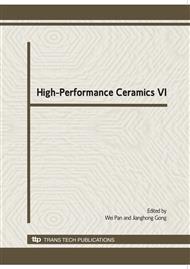p.522
p.526
p.530
p.534
p.538
p.542
p.546
p.549
p.554
Superoleophobic and Superhydrophobic Surfaces from Microtextured ZnO-Based Surfaces on Si Substrate
Abstract:
Theoretical calculations suggest that creating superoleophobic surfaces would require a surface energy lower than that of any known materials. In the present work, we demonstrate micronanostructured ZnO-based surfaces displaying apparent contact angles (CA) greater than 150, even with hexadecane (surface tension l = 27.5 mN/m). The specific ZnO microtextures were fabricated by a chemical solution method, and fluoroalkylsilane (FAS) was then used to tune the surface wettability. The combination of ZnO microtextures and FAS modification resulted in a superoleophobicity with CA for hexadecane was 154.6 (161.9 for diethylene glycol (l = 45.2 mN/m). This apparent superoleophobic behavior was induced on intrinsically oleophilic materials mainly by topography (i.e. the specific ZnO microtextures), which form a composite surface of air and solid with oil drop sitting partially on air. Such special wetting state is a metastable Cassie state. The results are expected to promote the study on self-cleaning applications, especially in the condition with oil contaminations.
Info:
Periodical:
Pages:
538-541
Citation:
Online since:
March 2010
Authors:
Keywords:
Price:
Сopyright:
© 2010 Trans Tech Publications Ltd. All Rights Reserved
Share:
Citation:


